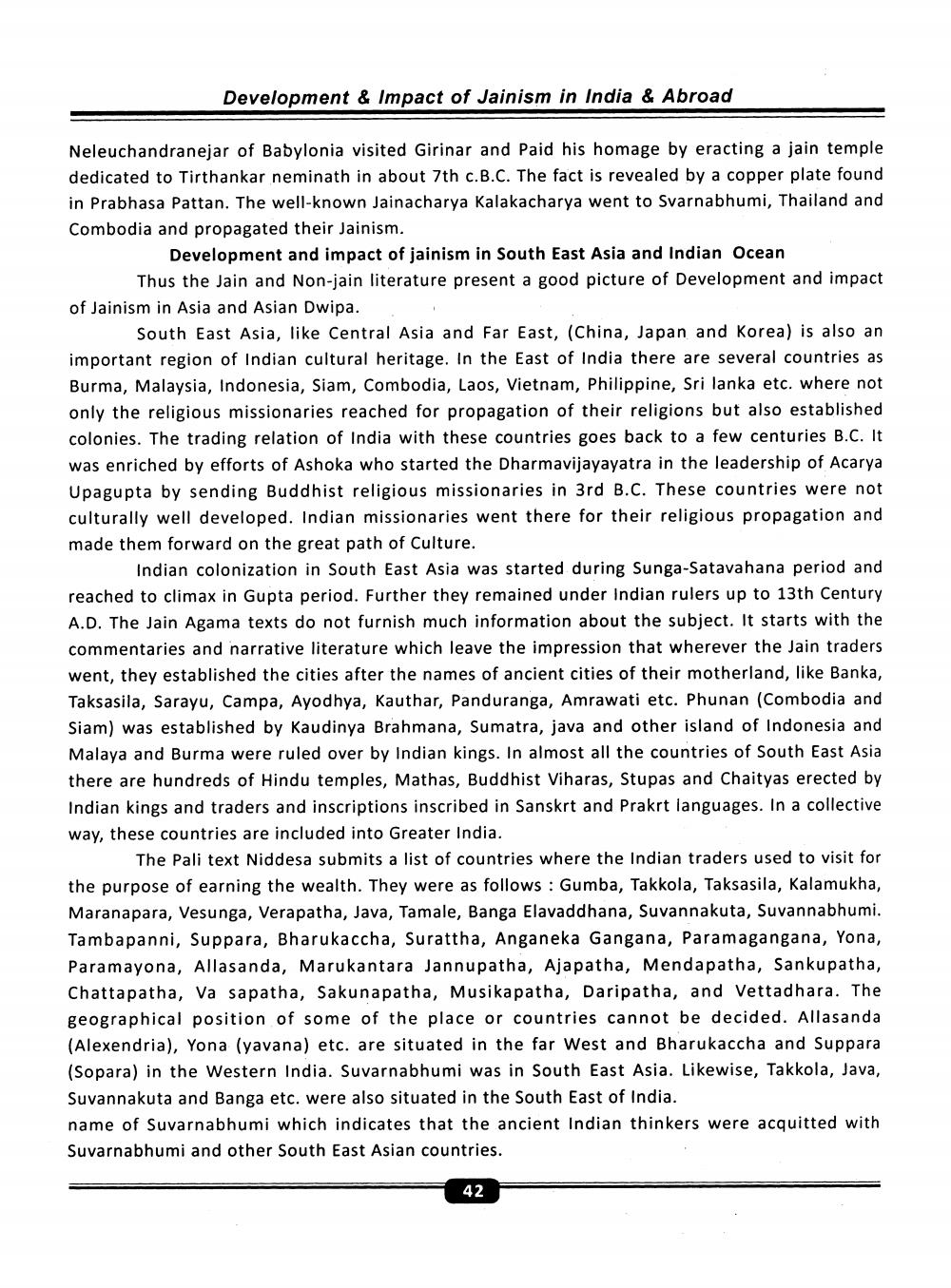________________
Development & Impact of Jainism in India & Abroad
Neleuchandranejar of Babylonia visited Girinar and Paid his homage by eracting a jain temple dedicated to Tirthankar neminath in about 7th c.B.C. The fact is revealed by a copper plate found in Prabhasa Pattan. The well-known Jainacharya Kalakacharya went to Svarnabhumi, Thailand and Combodia and propagated their Jainism.
Development and impact of jainism in South East Asia and Indian Ocean
Thus the Jain and Non-jain literature present a good picture of Development and impact of Jainism in Asia and Asian Dwipa.
South East Asia, like Central Asia and Far East, (China, Japan and Korea) is also an important region of Indian cultural heritage. In the East of India there are several countries as Burma, Malaysia, Indonesia, Siam, Combodia, Laos, Vietnam, Philippine, Sri lanka etc. where not only the religious missionaries reached for propagation of their religions but also established colonies. The trading relation of India with these countries goes back to a few centuries B.C. It was enriched by efforts of Ashoka who started the Dharmavijayayatra in the leadership of Acarya Upagupta by sending Buddhist religious missionaries in 3rd B.C. These countries were not culturally well developed. Indian missionaries went there for their religious propagation and made them forward on the great path of Culture.
Indian colonization in South East Asia was started during Sunga-Satavahana period and reached to climax in Gupta period. Further they remained under Indian rulers up to 13th Century A.D. The Jain Agama texts do not furnish much information about the subject. It starts with the commentaries and narrative literature which leave the impression that wherever the Jain traders went, they established the cities after the names of ancient cities of their motherland, like Banka, Taksasila, Sarayu, Campa, Ayodhya, Kauthar, Panduranga, Amrawati etc. Phunan (Combodia and Siam) was established by Kaudinya Brahmana, Sumatra, java and other island of Indonesia and Malaya and Burma were ruled over by Indian kings. In almost all the countries of South East Asia there are hundreds of Hindu temples, Mathas, Buddhist Viharas, Stupas and Chaityas erected by Indian kings and traders and inscriptions inscribed in Sanskrt and Prakrt languages. In a collective way, these countries are included into Greater India.
The Pali text Niddesa submits a list of countries where the Indian traders used to visit for the purpose of earning the wealth. They were as follows : Gumba, Takkola, Taksasila, Kalamukha, Maranapara, Vesunga, Verapatha, Java, Tamale, Banga Elavaddhana, Suvannakuta, Suvannabhumi. Tambapanni, Suppara, Bharukaccha, Surattha, Anganeka Gangana, Paramagangana, Yona, Paramayona, Allasanda, Marukantara Jannupatha, Ajapatha, Mendapatha, Sankupatha, Chattapatha, Va sapatha, Sakunapatha, Musikapatha, Daripatha, and Vettadhara. The geographical position of some of the place or countries cannot be decided. Allasanda (Alexendria), Yona (yavana) etc. are situated in the far West and Bharukaccha and Suppara (Sopara) in the Western India. Suvarnabhumi was in South East Asia. Likewise, Takkola, Java, Suvannakuta and Banga etc. were also situated in the South East of India. name of Suvarnabhumi which indicates that the ancient Indian thinkers were acquitted with Suvarnabhumi and other South East Asian countries.
42




